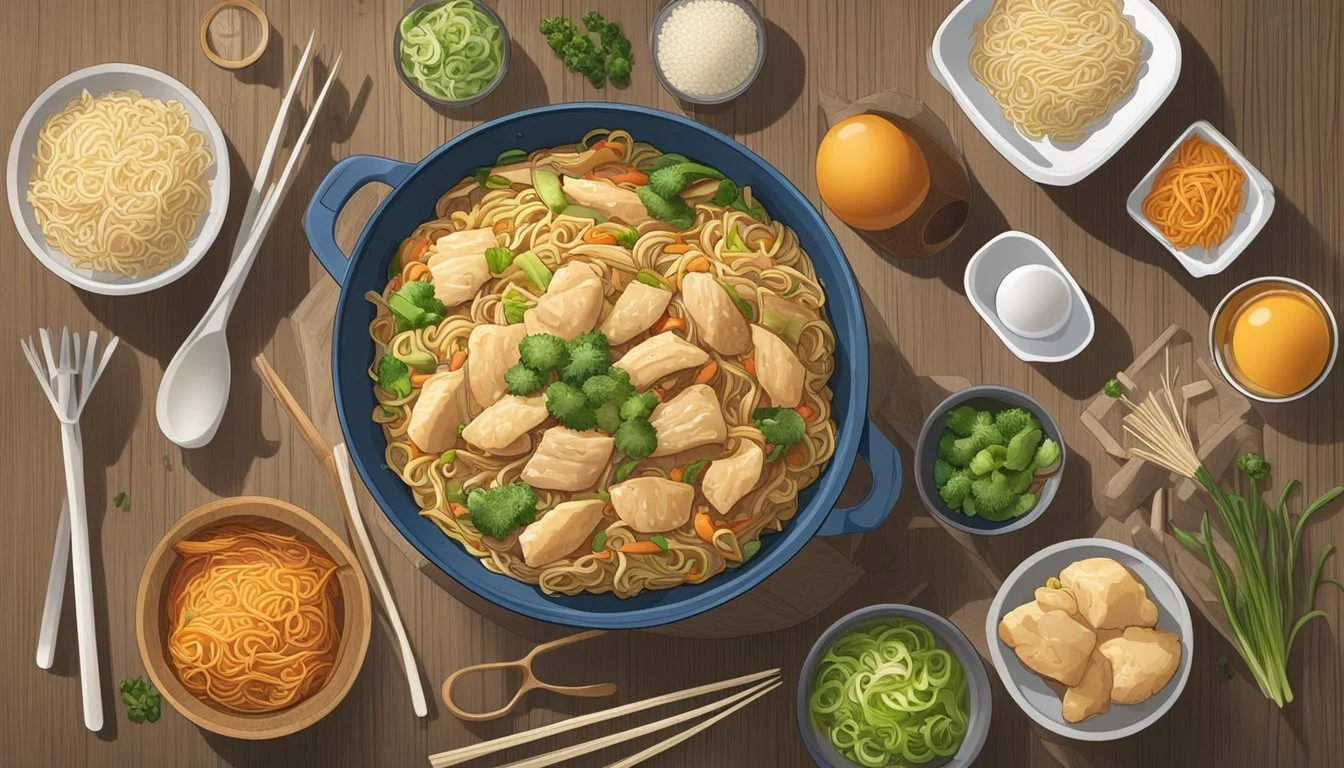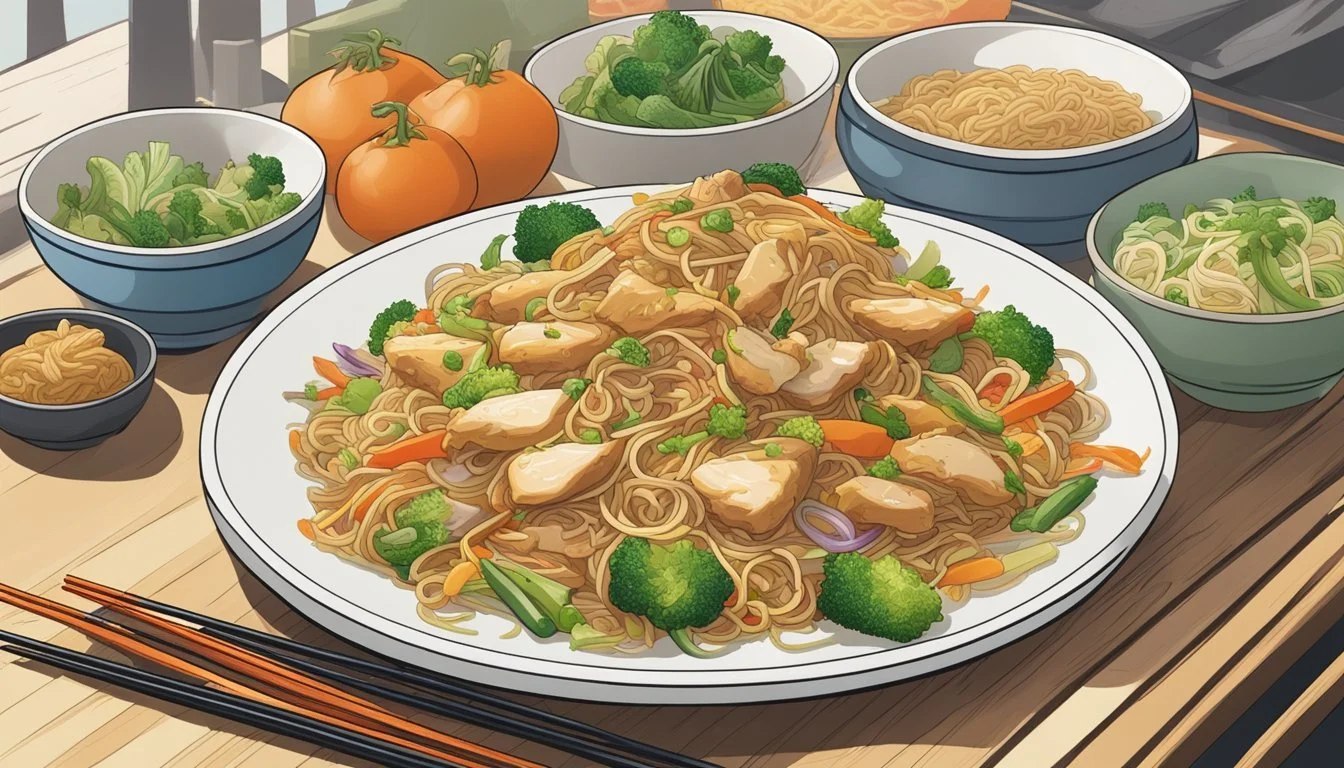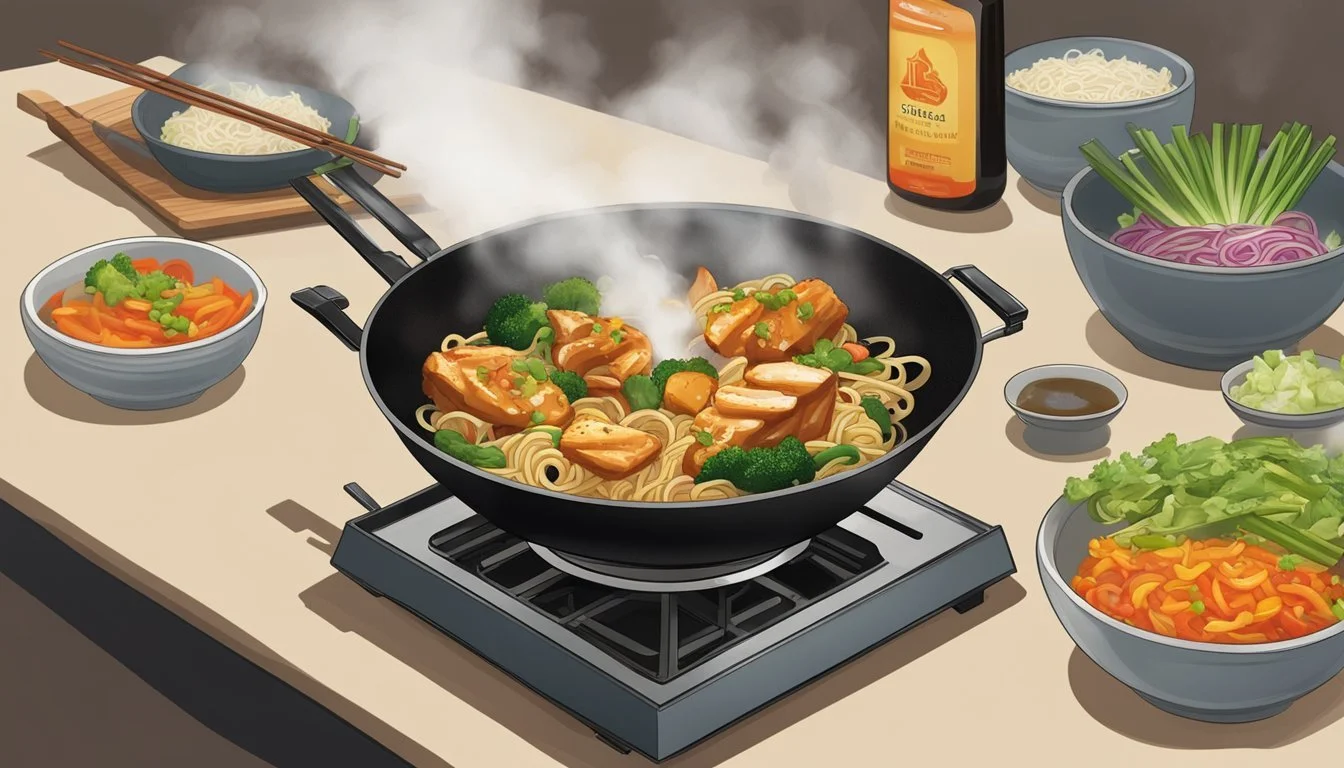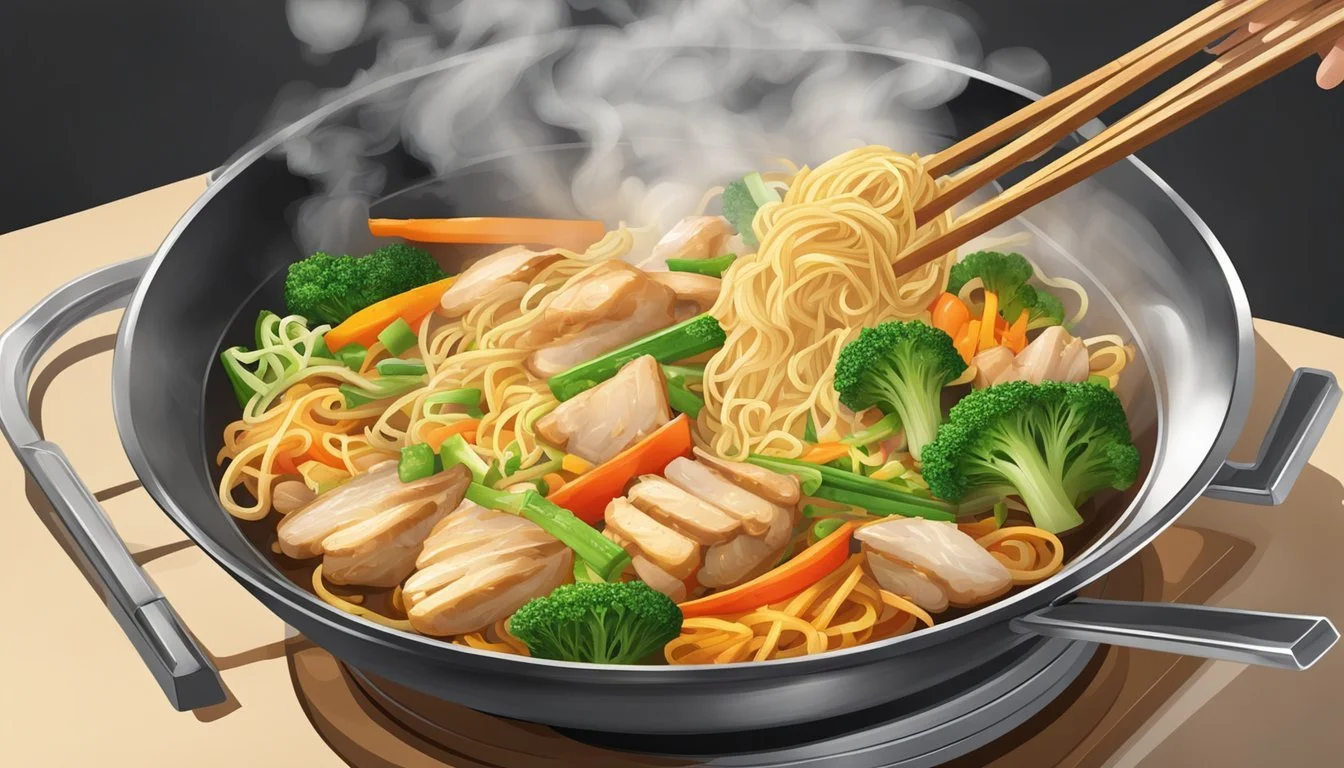How Long Does Chicken Chow Mein Last?
Storage Tips and Safety
Chicken chow mein is a beloved dish in many households, but leftovers can leave you wondering how long they last. When stored properly in the refrigerator, chicken chow mein can remain safe to eat for 3 to 4 days. This makes it a convenient option for meal prep or for enjoying a quick meal later in the week.
To extend its shelf life, freezing is a practical option. By placing chow mein in airtight containers or heavy-duty freezer bags, it can last up to two months in the freezer without compromising quality. This approach ensures you have a delicious dish ready whenever the craving strikes.
Storing it correctly from the outset is crucial for maintaining its taste and safety. Make sure to refrigerate your chicken chow mein within two hours of cooking to inhibit bacterial growth and preserve its wonderful flavors.
Understanding Chow Mein
Chow Mein is a traditional dish in Chinese cuisine, known for its distinctive noodles and savory combination of ingredients. Chicken chow mein, in particular, is a popular variation featuring tender chicken and an array of veggies.
Origins and Popularity of Chow Mein
Chow Mein originates from Northern China, where it became a staple comfort food. The dish's name translates to "stir-fried noodles," reflecting its preparation method. With its migration to the West, chow mein gained widespread popularity, becoming a favorite in Chinese-American cuisine. Over time, it has been adapted with various regional twists, leading to different versions such as the crispy and soft noodle varieties. Its flexibility and rich flavor profile contribute to its sustained appeal.
Ingredients Commonly Used in Chicken Chow Mein
Chicken chow mein combines several key ingredients: noodles, chicken, and vegetables. The noodles are typically made from wheat flour and egg, offering a firm texture. Common veggies include onions, celery, and cabbage. These are stir-fried with garlic and ginger for added depth of flavor.
The chicken is often marinated in a mixture of soy sauce and sesame oil before being cooked. A sauce made from soy sauce, oyster sauce, and sometimes hoisin sauce or rice wine adds richness to the dish. This balance of textures and flavors is what makes chicken chow mein a satisfying and versatile meal.
Comparison with Related Dishes like Lo Mein
Though chow mein and lo mein both feature noodles, there are distinct differences. Chow mein uses noodles that are either stir-fried until crisp or soft, depending on the recipe. Lo mein, on the other hand, uses fresh lo mein noodles or Chinese egg noodles which are boiled first and then tossed with a sauce.
Additionally, chow mein's stir-frying method creates a more textured noodle dish, while lo mein tends to be saucier and more relaxed in preparation. Ingredients for both can be similar, involving chicken, vegetables, and sauces, but their preparation methods result in unique tastes and textures.
Understanding these differences helps in appreciating the subtleties of Chinese noodle dishes._
Proper Storage of Chicken Chow Mein
Proper storage methods can significantly extend the shelf life of chicken chow mein. This section covers instructions for refrigerating leftovers, freezing for long-term storage, and the importance of using airtight containers.
Refrigerating Leftover Chicken Chow Mein
Refrigerate chicken chow mein promptly to keep it fresh. Store the dish within two hours of cooking to prevent bacterial growth.
Place the leftovers in sealed containers. This minimizes exposure to air and moisture. The chicken chow mein will last for about 3 to 4 days in the refrigerator.
Temperature is critical. Ensure your refrigerator is set below 40°F (4°C). This cool temperature helps preserve the quality and safety of the food.
Freezing Techniques for Extended Shelf Life
For longer storage, freezing is an effective method. Portion the chicken chow mein into meal-sized servings to make thawing and reheating easier.
Use heavy-duty freezer bags or airtight containers to prevent freezer burn. Label each container with the date to keep track of its shelf life.
Properly stored, frozen chicken chow mein can last for up to several months. To thaw, transfer the container to the refrigerator overnight before reheating.
Importance of Airtight Containers
Airtight containers are vital for extending the shelf life of chicken chow mein. They protect the food from external contaminants and moisture.
This storage method helps retain the texture and flavor of the dish. Heavy-duty freezer bags are also a good option for freezing, ensuring that the food remains protected in the freezer.
In addition to refrigerating and freezing, storing dry ingredients like noodles in a cool, dry place can further extend their longevity.
Safety and Quality Considerations
When dealing with chicken chow mein, ensuring safety and maintaining quality are crucial. These considerations help prevent foodborne illnesses and preserve the dish's taste and texture.
Identifying Signs of Spoilage
Detecting spoilage early can prevent health issues. Changes in appearance like discoloration or visible mold are clear indicators. Off odors that smell sour or unpleasant are also signs. Texture changes such as sliminess or excessive dryness suggest the food is no longer safe to eat.
Consumers should discard any leftovers that have an unusual appearance or smell. Visual and olfactory cues are typically reliable for identifying spoiled food.
Health Risks of Consuming Spoiled Food
Eating spoiled chicken chow mein can lead to food poisoning. Bacteria like Salmonella and E. coli can thrive in improperly stored food, causing symptoms such as nausea, vomiting, and diarrhea. These symptoms can occur within hours or days after consumption.
Severe cases may require medical attention. Vulnerable populations, such as the elderly, young children, and individuals with compromised immune systems, should be especially cautious. Proper storage and timely consumption are essential for avoiding these risks.
Properly Handling Chicken Chow Mein to Prevent Bacteria Growth
To prevent bacterial growth, chicken chow mein should be refrigerated within two hours of cooking or purchasing. Store it in airtight containers to maintain freshness and prevent contamination. The refrigerator should be set at or below 40°F (4°C).
When reheating, ensure the internal temperature reaches 165°F (74°C) to kill harmful bacteria. Avoid reheating chow mein more than once as this increases the risk of bacterial growth. Always check the texture and smell before consuming reheated food.
By adhering to these safety practices, one can enjoy chicken chow mein without compromising on health.
Cooking Tips for Homemade Chow Mein
Preparing delicious homemade Chicken Chow Mein involves carefully selecting ingredients, mastering the stir-frying technique, and balancing flavors with sauces and seasonings.
Selecting the Right Ingredients
Quality ingredients are crucial for tasty Chow Mein. Fresh vegetables like carrots, snap peas, and onions add crunch and color. Use chicken breast or thighs for their tenderness. Ginger and garlic should be fresh to impart a robust flavor.
Chow Mein noodles are a must; they offer the correct texture and absorb sauces well. Opt for light soy sauce and oyster sauce for authentic taste. Sesame oil adds a nutty fragrance, while a touch of sugar and white pepper balances flavors.
Mastering the Stir-Frying Technique
Stir-frying high heat is key to achieving the signature Chow Mein texture. Use a large wok or nonstick skillet to ensure even cooking. Heat vegetable oil until smoking, then add chicken, stir-frying until golden. Remove and set aside.
Quickly cook ginger, garlic, and vegetables, ensuring they stay crisp. Combine ingredients back into the wok, maintaining high heat for a quick, even coating. Consistent stirring prevents burning and ensures a uniform blend of flavors.
Balancing Flavors with Sauces and Seasoning
A harmonious Chow Mein relies on balanced sauces and precise seasoning. Combine soy sauce, oyster sauce, sesame oil, and a pinch of sugar. Adjust proportions based on taste preference.
Incorporate sauces early on, tossing ingredients to coat evenly. For additional depth, consider adding chili sauce for spice. Salt and pepper should complement but not overpower the dish. Garnish with freshly chopped green onions for a fresh, zesty finish.
Understanding these elements will elevate the dish, ensuring every bite is flavorful and authentic.
Optimizing Leftover Chicken Chow Mein Usage
Utilizing leftover chicken chow mein effectively can help reduce waste and make meals more exciting. Here are some creative ideas, ways to transform leftovers into new dishes, and important food safety tips.
Creative Ideas for Repurposing Leftovers
Leftover chicken chow mein can be repurposed in various ways. For instance, it can be used as a filling for spring rolls or dumplings.
Another fun idea is to stuff bell peppers with the chow mein, then bake them for a flavorful twist.
Wrap the chow mein in lettuce leaves to create a refreshing and crunchy bite.
Additionally, consider using it as a base for a stir-fry by simply adding extra vegetables or proteins.
Transforming Leftovers into New Meals
Transform leftover chicken chow mein into a brand-new meal by integrating it with different ingredients.
Create a fried rice dish by mixing the chow mein with cooked rice, scrambled eggs, and soy sauce.
For a soup, add the chow mein to a broth with vegetables and tofu for a hearty noodle soup.
Alternatively, top baked chow mein with cheese and breadcrumbs for an oven-baked casserole.
You can also fold the chow mein into omelets or make chow mein stuffed burritos with beans and salsa.
Food Safety Tips for Reusing Leftover Chicken Chow Mein
To ensure food safety, always store leftover chicken chow mein in an airtight container in the refrigerator.
It typically lasts 3 to 4 days but should be consumed sooner for optimal taste.
Freezing is another option; place the chow mein in heavy-duty freezer bags or containers. When ready to eat, thaw in the fridge before reheating.
Reheat leftovers thoroughly, ensuring an internal temperature of 165°F (74°C) to prevent foodborne illnesses.
Check for signs of spoilage like sour smell or color change before consuming. Avoid leaving the chow mein at room temperature for more than two hours.
Additional Tips for Chow Mein Preparation
Mastering the art of chow mein involves paying attention to several key aspects: cooking noodles properly, selecting and preparing vegetables, and efficiently incorporating meats or their alternatives. Each step is crucial to creating a perfectly balanced and flavorful dish.
Cooking Perfect Chow Mein Noodles
Properly cooked chow mein noodles are the foundation of a great dish. Dried chow mein noodles require boiling according to package instructions until they reach an al dente texture.
After boiling, rinse the noodles with cold water to stop cooking and prevent sticking. For a classic, slightly crispy texture, fry the noodles in a hot skillet with a bit of oil until they are golden brown. This method also enhances the dish's overall flavor.
Vegetable Selection and Preparation
Select a variety of fresh vegetables to add texture and flavor. Cabbage, carrots, and celery are common choices. Thinly slice or julienne the vegetables for even cooking.
Adding mushrooms, bean sprouts, and water chestnuts can provide unique textures and tastes. Enhance flavors by stir-frying vegetables in a hot wok before combining them with the noodles and meat. Ensuring vegetables retain a slight crunch can improve the overall eating experience.
Incorporating Meats and Alternatives
For meat options, chicken, pork, and beef work well. Marinate the meats in soy sauce, cooking wine, and cornstarch to enhance flavor and tenderness. Cook the meat thoroughly in a hot skillet before adding it to the noodles and vegetables.
Consider alternatives like tofu or tempeh for a vegetarian option. These can be marinated and cooked similarly to meat, ensuring they absorb the flavors of the sauce and other ingredients. To maintain freshness, store leftovers in airtight containers promptly after cooking.








